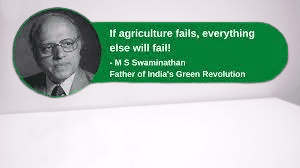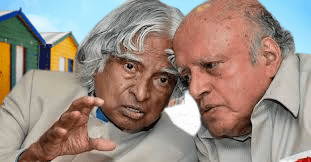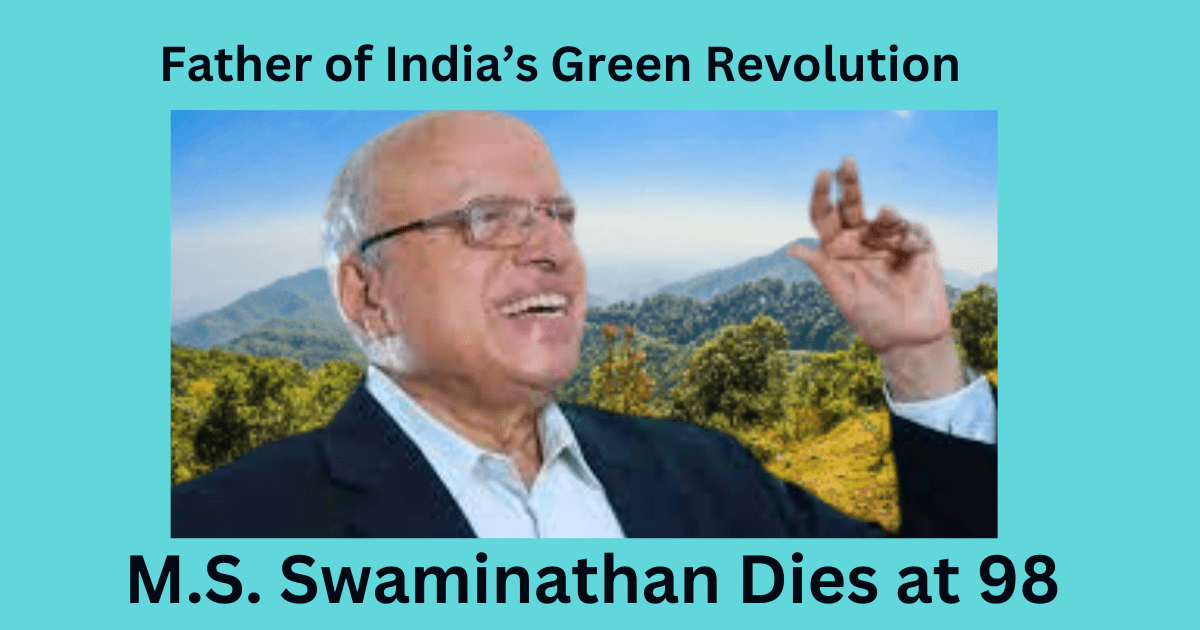MS Swaminathan: Renowned pioneer of the Green Revolution in India, MS Swaminathan, passes away at age 98 in Chennai on 28th September’2023.
Dr Soumya Swaminathan, former Chief Scientist and former Deputy Director General at the WHO and daughter of MS Swaminathan told ANI, “He was not keeping well for the last few days… His end came very peacefully this morning… Till the end, he was committed to the farmers’ welfare and to the upliftment of the poorest in society. On behalf of the family, I would like to thank everyone who has expressed their wishes.”

“I hope that the three of us daughters will continue the legacy that my father and my mother, Mina Swaminathan, have shown us… My father was one of the few people who recognized that women are neglected in agriculture… He had taken a lot of initiatives to promote women’s empowerment… His ideas have led to programs like the Mahila Sashaktikaran Yojana, meant to support women farmers. When he was a member of the Sixth Planning Commission, for the first time, there was a chapter on gender and environment included… These are the two contributions of which he was very proud,” Dr Soumya Swaminathan further added.
He founded the MS Swaminathan Research Foundation (MSSRF) in 1988, using the proceeds from the First World Food Prize he was awarded in 1987. An official from the institute confirmed that he breathed his last around 11 am.
Prime Minister Narendra Modi wrote, “Deeply saddened by the demise of Dr. MS Swaminathan Ji. At a very critical period in our nation’s history, his groundbreaking work in agriculture transformed the lives of millions and ensured food security for our nation.”
MS Swaminathan
MS Swaminathan, regarded as the father of India’s Green Revolution, passed away in Chennai on Thursday. He was 98. Swaminathan was the founder of MS Swaminathan Research Foundation (MSSRF). Family sources confirmed that he passed away at his residence in Teynampet at 11.15am following age-related ailments.
The Padma awardee took great efforts in recognising the role of women in the Indian agricultural sector, and rolled out several initiatives, including the Mahila Sashaktikaran Yojana, to empower women in the country.

Father of Green Revolution in India
Swaminathan was chiefly responsible for bringing in the social and agricultural revolution in India during the 1960s when the country was struggling with a famine-like situation. By injecting strategic policies, and developing high-yielding seeds suited to the Indian climate, he ensured a wave of change at the grassroots level in the Indian agricultural space.
The agriculture scientist served as the Director of the Indian Agricultural Research Institute from 1961 to 1972. Following this, he served as the Director General at ICAR and Secretary to the Government of India at the Department of Agricultural Research and Education from 1972 to 1979. Swaminathan also took up the position of the Principal Secretary in the Ministry of Agriculture between 1979 and 1980.

From 1980 to 1982, he served as the Acting Deputy Chairman, then Member (Science and Agriculture) of the Planning Commission. Later, from 1982 to 1988, Swaminathan served as the Director General at the International Rice Research Institute in the Philippines, which is funded by the Rockefeller Foundation.
In 1987, he was awarded the first World Food Prize after which Swaminathan set up the MS Swaminathan Research Foundation (MSSRF) in Chennai’s Taramani by using the $200,000 prize money.
Applauding the scientist’s condemnable efforts to bring in a Green Revolution in India, erstwhile United Nations secretary general, Javier Pérez de Cuéllar, had defined Swaminathan as “a living legend who will go into the annals of history as a world scientist of a rare distinction”.
Swaminathan was also appointed chair of the National Commission on Farmers in 2004. This commission was aimed at recognising farmer distress amid alarming suicide cases across the nation.
According to a Time magazine review, Swaminathan was one of the 20 most influential people to see Asia in the 20th century.
Fond remembrance by daughter Dr Soumya Swaminathan
Soumya Swaminathan, daughter of Swaminathan, in an interaction with the media later today, said that the scientist had not been keeping well for the last few days. “His end came very peacefully this morning,” said his daughter, who is also the former Deputy Director General of WHO. “Till the end, he was committed to the farmers’ welfare and to the upliftment of the poorest in society”, she further added.
She also remembered the late scientist fondly for recognising the role of women in Indian agricultural practises. “My father was one of the few people who recognised that women are neglected in agriculture. He had taken a lot of initiatives to promote women’s empowerment. His ideas have led to programs like the Mahila Sashaktikaran Yojana, meant to support women farmers”.
She hailed Swaminathan’s efforts in introducing a chapter on gender and environment during his tenure at the Sixth Planning Commission.
President of India, Droupadi Murmu also paid her tribute to the crop geneticist. Applauding his efforts for ensuring food security in India, the president wrote on X, “A visionary who worked endlessly to achieve food security, he was rightly called the Father of Green Revolution that ensured our country’s self-reliance in food grains”.
“He pioneered path-breaking research in the agriculture science for which he got a range of awards- from Padma Vibhushan to the prestigious World Food Prize. He leaves behind a rich legacy of Indian agriculture science which may serve as a guiding light to steer the world towards a safer and hunger-free future for humanity,” said the president.
MS Swaminathan: Background
Mankombu Sambasivan Swaminathan (7 August 1925 – 28 September 2023) was an Indian agronomist, agricultural scientist, plant geneticist, administrator, and humanitarian. Swaminathan was a global leader of the green revolution. He has been called the main architect of the green revolution in India for his leadership and role in introducing and further developing high-yielding varieties of wheat and rice.
Swaminathan’s collaborative scientific efforts with Norman Borlaug, spearheading a mass movement with farmers and other scientists and backed by public policies, saved India and Pakistan from certain famine-like conditions in the 1960s. His leadership as director general of the International Rice Research Institute (IRRI) in the Philippines was instrumental in his being awarded the first World Food Prize in 1987, recognized as one of the highest honours in the field of agriculture. The United Nations Environment Programme has called him “the Father of Economic Ecology”.
MS Swaminathan contributed basic research related to potato, wheat, and rice, in areas such as cytogenetics, ionizing radiation, and radiosensitivity. He has been a president of the Pugwash Conferences and the International Union for Conservation of Nature.
In 1999, he was one of three Indians, along with Gandhi and Tagore, on Time‘s list of the 20 most influential Asian people of the 20th century. Swaminathan received numerous awards and honours, including the Shanti Swarup Bhatnagar Award, the Ramon Magsaysay Award, and the Albert Einstein World Science Award. Swaminathan chaired the National Commission on Farmers in 2004, which recommended far-reaching ways to improve India’s farming system. He was the founder of an eponymous research foundation.
He coined the term ‘Evergreen Revolution’ in 1990 to describe his vision of “productivity in perpetuity without associated ecological harm”. He was nominated to the Parliament of India for one term between 2007 and 2013. During his tenure he tabled a bill for the recognition of women farmers in India.
Early Life of MS Swaminathan
MS Swaminathan was born in Kumbakonam, Madras Presidency (present-day Thanjavur, Tamil Nadu, India)on 7 August 1925. He was the second son of general surgeon M. K. Sambasivan and Parvati Thangammal Sambasivan, who hailed from Alappuzha district in Kerala. At age 11, after his father’s death, Swaminathan was looked after by his father’s brother.
Educational Background of MS Swaminathan
10th: Catholic Little Flower High School in Kumbakonam, Tamilnadu
Undergraduate degree in zoology at Maharaja’s College in Trivandrum, Kerala (now known as University College, Thiruvananthapuram at the University of Kerala)
Bachelor of Science degree in Agricultural Science ( University of Madras (Madras Agricultural College, now the Tamil Nadu Agricultural University) from 1940 to 1944
Post-graduate degree with high distinction in cytogenetics in 1949 ( Indian Agricultural Research Institute (IARI) in New Delhi (genetics and plant breeding )
Social pressures resulted in him competing in the examinations for civil services, through which he was selected to the Indian Police Service
UNESCO fellowship in genetics in the Netherlands (Swaminathan was a UNESCO fellow at the Wageningen Agricultural University, Institute of Genetics in the Netherlands, for eight months.
Doctor of Philosophy degree in 1952 for his thesis “Species Differentiation, and the Nature of Polyploidy in certain species of the genus Solanum – section Tuberarium (Plant Breeding Institute of the University of Cambridge School of Agriculture).
Post-doctoral research associateship at the University of Wisconsin, Laboratory of Genetics to help set up a USDA potato research station (15 moths in the United States )
His associateship ended in December 1953. Swaminathan turned down a faculty position in order to continue to make a difference back home in India. Swaminathan returned to India in early 1954.
Professional Career
1954 – Assistant botanist at Central Rice Research Institute in Cuttack, India
1954 – Assistant cytogeneticist (Indian Agricultural Research Institute (IARI) in New Delhi in October 1954)
MS Swaminathan was critical of India importing food grains when seventy percent of India was dependent on agriculture. Further drought and famine-like situations were developing in the country.
Swaminathan and Norman Borlaug ( Norman Ernest Borlaug was an American agronomist who led initiatives worldwide that contributed to the extensive increases in agricultural production termed the Green Revolution. Borlaug was awarded multiple honors for his work, including the Nobel Peace Prize, the Presidential Medal of Freedom and the Congressional Gold Medal ) collaborated, with Borlaug touring India and sending supplies for a range of Mexican dwarf varieties of wheat, which were to be bred with Japanese varieties. Initial testing in an experimental plot showed good results.
The crop was high-yield, good quality, and disease free. There was hesitation by farmers to adopt the new variety whose high yields were unnerving. In 1964, following repeated requests by Swaminathan to demonstrate the new variety, he was given funding to plant small demonstration plots. A total of 150 demonstration plots on 1 hectare were planted.
The results were promising and the anxieties of the farmers were reduced. More modifications were made to the grain in the laboratory to better suit Indian conditions. The new wheat varieties were sown and in 1968 production went to 17 million tonnes, 5 million tonnes more than the last harvest.
Just before receiving his Nobel Prize in 1970, Norman Borlaug wrote to Swaminathan:
The Green Revolution has been a team effort and much of the credit for its spectacular development must go to the Indian officials, organizations, scientists, and farmers. However, to you, Dr. Swaminathan, a great deal of the credit must go for first recognizing the potential value of the Mexican dwarfs. Had this not occurred, it is quite possible that there would not have been a Green Revolution in Asia.
The Government of India declared India self-sufficient in food production in 1971.
In 1972, Swaminathan was appointed as the director-general of the Indian Council of Agricultural Research (ICAR) and a secretary to the Government of India.
In 1979, in a rare move for a scientist, he was made a principal secretary, a senior position in the Government of India.
In 1980, he was shifted to the Planning Commission
His shift to the Planning Commission for two years resulted in the introduction of women and environment with respect to development in India’s five year plans for the first time.
In 1982, he was made the first Asian director general of the International Rice Research Institute (IRRI) in the Philippines

One of the contributions he made during his tenure here was conducting an international conference “Women in Rice Farming Systems”. For this, the United States-based Association for Women in Development gave Swaminathan their first award for “outstanding contributions to the integration of women in development”.
In 1984 he became the president and vice-president of the International Union for Conservation of Nature and World Wildlife Fund respectively
In 1987 he was awarded the first World Food Prize. The prize money was used to set up the MS Swaminathan Research Foundation
Swaminathan established the Nuclear Research Laboratory at the IARI
He played a role in and promoting the setting up of the International Crop Research Institute for the Semi-Arid Tropics in India; the International Board for Plant Genetic Resources (now known as Bioversity International) in Italy and the International Council for Research in Agro-Forestry in Kenya.
MS Swaminathan co-chaired the United Nations Millennium Project on hunger from 2002 to 2005
Swaminathan was the chair of the National Commission on Farmers constituted in 2004
In 2007, President A.P.J. Abdul Kalam nominated MS Swaminathan to the Rajya Sabha.
Personal life
MS Swaminathan was married to Mina Swaminathan, whom he met in 1951 while they were both studying at Cambridge. They lived in Chennai, Tamil Nadu. Their three daughters are Soumya Swaminathan (a pediatrician), Madhura Swaminathan (an economist), and Nitya Swaminathan (gender and rural development). Gandhi and Ramana Maharshi influenced his life. Of the 2000 acres owned by their family, they donated one-third to Vinoba Bhave’s cause. In an interview in 2011, he said that when he was young, he followed Swami Vivekananda. MS Swaminathan died at his home in Chennai on 28 September 2023, at the age of 98.
For more articles stay in touch with read4knowledge.

1 thought on “MS Swaminathan, father of India’s Green Revolution, legendary agricultural scientist dies at 98, Most unknown facts”